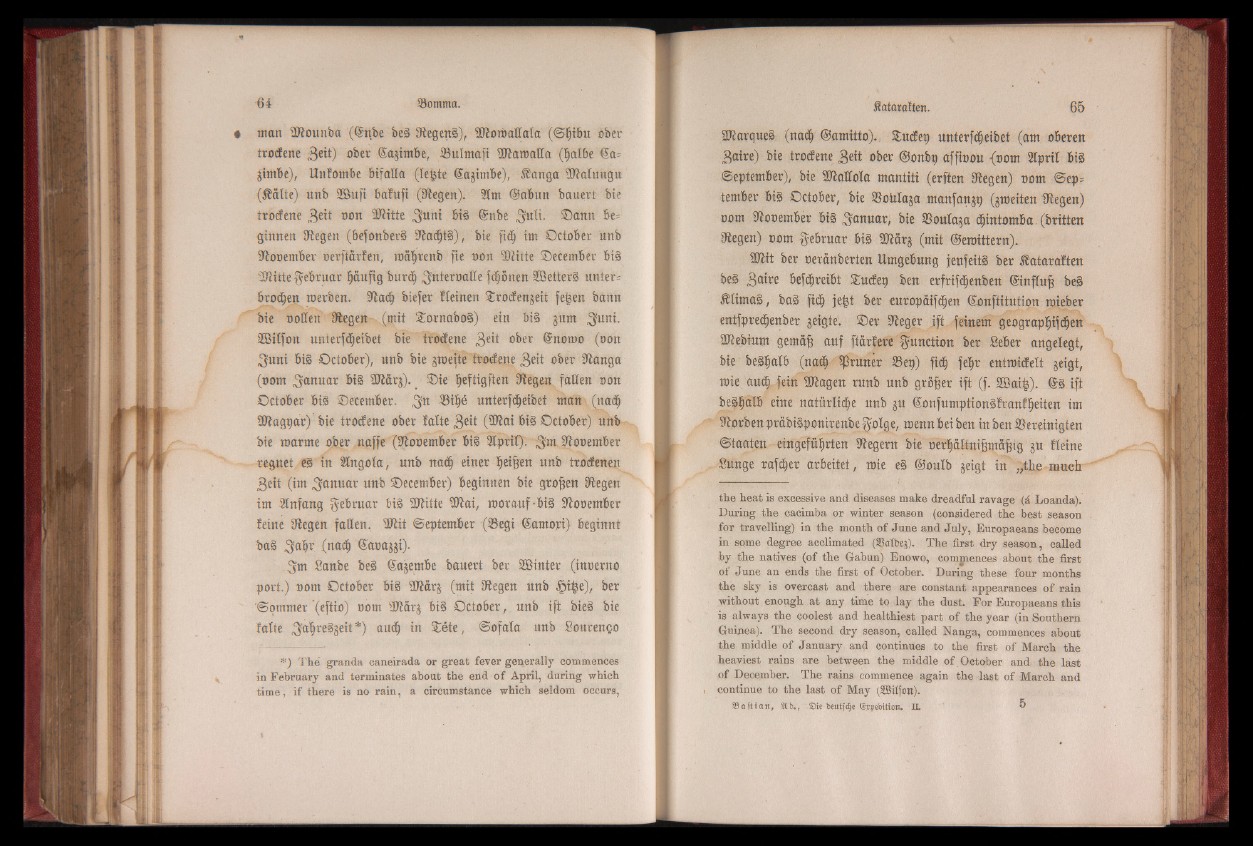
• man SDlounba '(©nbe beg Dlegettg), SDiorbaffata (@I)tbu ober
trocEene geit) obex ©ajtmbe, 23uima[t Sftaroalla (fjalbe ©a=
gtmbe), Uufombe bifalla (te&te ©ajtmbe), Slanga üftatungu
(Jtalte) unb SCBuft bafuft (Olegen). 2tm ©abun bauert bte
trorfene jgeit oo« ^ itt e (yuttt big ©nbe 3 uli. ©ann besinnen
Regelt (befonberg 3flac^t§), bte fid) im October unb
Stooember oerftarfen, ntafjrenb jte non sD(itte ©ecember big
‘¡Kitte ^ebruar Ijaufig burcf) ^nternalle frönen SSetterg unter=
broken tnerben. 9lacf) biefer flehten ©rocfenjeit fe|en bann
bie ooEen Siegen (mit ©ornabog) ein big jum 3 uni.
SBilfon unterfc^eibet bie trocfene 3 eit 0*>er ©noroo (non
3 uni bi§ October), unb bie pteite trocfene 3eit ober Dianga
(nom J a n u a r big Karg). ©ie ^eftigften Siegen fatten non
October big ©ecember. 3 n Bi§e unterfdjeibet man1 (nadj
SDiagpar) bie trocfene ober falte 3eit (K a i big October) unb
bie marine ober naffe (Sionember big 2lpril). (ym Sionember
regnet eg in Slngola, unb nacfj einer Reifen unb trodenen
3 eit (im J a n u a r unb ©ecember) beginnen bie großen Siegen
im Anfang Februar big Kitte K a i, morauf-big Sionember
feine Siegen fatten. K it September (tBegi ©amori) beginnt
bag (yaijr (nadj ©aoajgi).
^m Sanbe beg ©ajetnbe bauert ber SSinter (innerno
port.) nom October big Karg (mit Siegen unb fpiije), ber
Sommer (eftio) nom Karg big October, unb ift bieg bie
falte (jatjreggeit *) audj in ©ete, Sofala unb Sourengo
*) The granda caneirada or great fever generally commences
in February and terminates about the end of April, during which
time, if there is no rain, a circumstance which seldom occurs,
Karques (nact) ©amitto). ©ucfet) unterfdjeibet (am oberen
3 aire) bie trodene get* ober ©onbp affinou {nom 2lpril big
September), bie SOiattofa mantiti (erften Siegen) nom Sep=
tember big October, bie SSoitlaga manfangp (groeiten Siegen)
nom Sionember big Januar, bie SBoulaga cf)intomba (britten
Siegen) nom gebruat big Karg (mit ©emittern).
K it ber neranberten Umgebung jenfeitg ber ßataraften
beg ,3 atre befdjreibt ©ucfep ben erfrtfdjenben ©influfi beg
Ätimag, bag fief) je^t ber europaifdjen ©onftitution raieber
entfpredjenber geigte, ©er Sieger ift feinem geograpf)i)dE)en
Kebium gemaf? auf ftarfere function ber Seber angelegt,
bie begfialb (nadj tjSruner S3ep) fid) fefjr entinidett geigt,
tnie audj fein Kagen runb unb grower ift (f. ©Batfj). @g ift
beS^aXb eine natürliche unb gu ©onfumptiongfranf^eiten im
Siorbenprabigponirenbe0oIge, tnennbeiben in ben ^Bereinigten
Staaten eingefüfjrten Siegern bie oerfjaltnifjmafitg gu fteine
Sunge ra fte r arbeitet, tnie eg ©outb geigt in „the much
the heat is excessive and diseases make dreadful ravage (ä Loanda).
During the cacimba or winter season (considered the best season
for travelling) in the month of June and July, Europaeans become
in some degree acclimated (SBalbej). The first dry season, called
by the natives (of the Gabun) Enowo, commences about the first
of June an ends the first of October. During these four months
the sky is overcast and there are constant appearances of rain
without enough at any time to :lay the dust. For Europaeans this
is always the coolest and healthiest part of the year (in Southern
Guinea). The second dry season, called Nanga, commences about
the middle of January and continues to the first of March the
heaviest rains are between the middle of . October and the last
of December. The rains commence again the last of March and
continue to the last of May (SSBilfott).
S a f t t a n , SCfc., S i e b e u t f d j e (S rp eb ttio n . IL 5